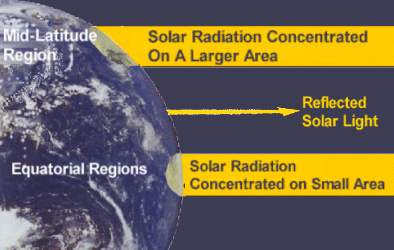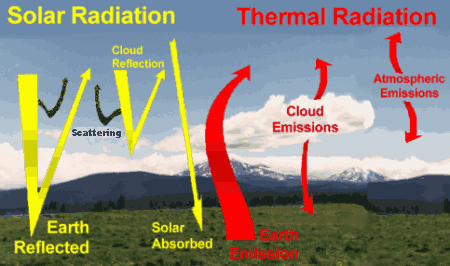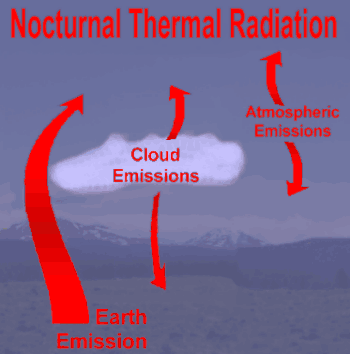 |
 |
| Home | Welcome | What's New | Site Map | Glossary | Weather Doctor Amazon Store | Book Store | Accolades | Email Us |
 | |||||||||
Balancing RadiationWhen I began working on articles on fog and frost, I realized some important atmospheric concepts were the basis for both. So rather than make those essays too long, I decided to lay a little groundwork for the science of the sky. Fog and frost may both form as a consequence of nocturnal(during the night) thermal radiation exchanges near the surface that lower temperatures until atmospheric water vapour changes to a liquid or solid state. Elsewhere, I discuss relevant aspects of humidity, but herein I tackle the radiation balance. It is a basic concept for many weather and climate topics including the high profile concern over the so-called greenhouse gases and their role in global warming. Close to the planet's surface, the radiation balance plays a major role in determining the weather conditions we feel. (Note that here I consider radiation as a form of energy delivered over time onto an area.) To start, let's step back from Earth, way back, about 150 million kilometres (93 million miles) to our personal star, the Sun. The Sun produces a tremendous amount of energy in its solar furnaces that it emits as short-wave radiation into the universe. An extemely small fraction falls on the sunlit side of the Earth, some of which is reflected back. The amount reflected, known as the albedo, is about 36 percent for the whole Earth, but can be above 90 percent for "bright" surface areas such as snow, ice and clouds, and as low as 10 percent or less for dark rocks and forests. The remaining fraction of the incoming solar radiation, called insolation by meteorologists, heats the Earth system through absorption by atmospheric gases, water, rock, soil, vegetation and building materials.  If the Earth were not able to lose that energy, the planet would soon become a molten ball, which over geological time would evaporate and eventually disperse across the solar system. Fortunately, the physical nature of all matter provides a remedy. Every body, from gas giants to molecules and atoms, radiates energy at a rate dependent on its physical nature (density, molecular and atomic structure, etc.) and its temperature. Every body in the universe sends its heat energy out to the surroundings and receives energy back from every object in its view. When more energy is gained than lost, the body warms. When more energy is lost than gained, the body cools. When there is a balance between gain and loss, the body can maintain a constant temperature. Now this basic concept applies best on a system more or less in radiative equilibrium, or when viewed over long time scales, but on our home planet, short-term, fluctuating radiant energy emissions are the norm. We see this every day. The sun — a huge source of radiant energy — rises and as it moves across the sky toward setting, our little patch of planet receives varying amounts of insolation. If we consider daily and hourly differences in radiation acting over the whole Earth, and also account for seasonal cycles and cloud cover variations, it becomes obvious that the insolation energy received can be quite variable from one location to the next. The unequal amounts of insolation received across the globe produces well-known temperature variations. It is thus typically hotter during the day and in equatorial regions, and colder at night and at the poles. The Earth system tries, albeit unsuccessfully, to redistribute that heat energy from warm to cold regions so that the planet would have a uniform temperature. Two fluids are called upon to transport that heat: water in the oceans and gases in the atmosphere. In the atmosphere, the energy redistribution process (generally expressed as heat transport) is known as the weather. Now, let's concentrate on the radiation balance of a small parcel of the Earth system surrounding us. We'll ignore in this discussions the complications introduced by water, fascinating though it is.  During daylight hours, the insolation entering our parcel of air, minus the reflected part, is absorbed by atmospheric gases and particles and the surface materials (rock, water, soil, vegetation). Thermal (heat) radiation (emitted by the planet and its elements as long-wave radiation) is also exchanged among the atmospheric constituents and surface elements. Since the rate of energy gained and lost varies among the elements, portions of the system may store some energy as internal heat for a time. With the sun in the sky providing a strong energy input, there is usually a net gain of energy during the day in the atmosphere, mostly at the surface where air molecules are warmed through heat conduction.  At night, however, it is a very different picture: the sun's direct energy input is cut off, and the strongest energy input to the surface ceases. The earth's surface, however, continues to radiate heat away, and thus cools. How much energy is lost depends on the length of the night and the nature (including the temperature) of the atmospheric and surface elements. Rock and snow, for example, radiate heat differently, with snow losing its heat much faster. Water in the atmosphere (clouds and vapour) absorbs thermal radiation well and re-radiates a portion back toward the surface. Thus, the surface generally regains more of its lost heat radiation on humid or cloudy nights, and therefore, the air in contact with the surface cools more slowly. Maximum radiational cooling of the surface and the surface air is observed on long, clear nights with low humidity, and cooling under these conditions is often rapid. Learn More From These Relevant Books
|
|||||||||
 |
To Purchase Notecard, |
Now Available! Order Today! | |
 |
 |
NEW! Now Available in the US! |
The BC Weather Book: |


